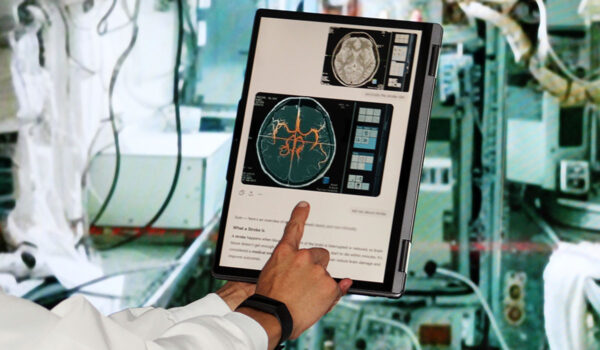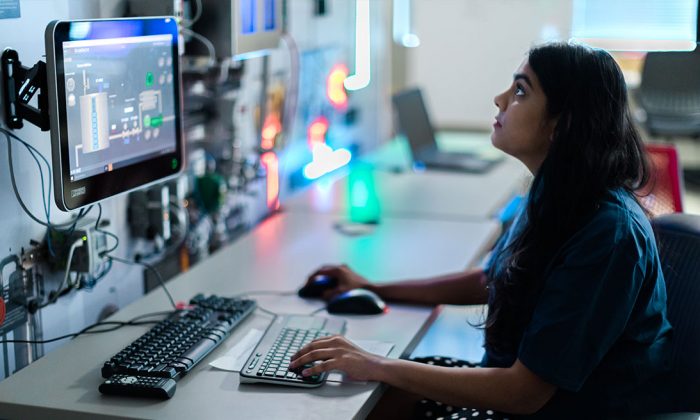Just weeks after the historic integration of UTSA and The University of Texas Health Science Center at San Antonio, research leaders from precision medicine and AI are leaning into novel, interdisciplinary collaboration, bringing together experts to explore how artificial intelligence can revolutionize healthcare.
Hosted jointly by MATRIX: The UTSA AI Consortium for Human Well-Being and UT San Antonio Health Science Center’s Center for Precision Medicine, the two-day AHHSA 2025: Advances in Human Health through Spatial Omics and AI will be held September 29–30 across two UT San Antonio campuses.
Cutting-edge fields unite to transform health
The event is designed to ignite breakthroughs at the intersection of medicine, artificial intelligence, neurotechnology, systems biology and telecommunications for extreme environments.
This unique combination addresses the need for cross-disciplinary solutions to some of society’s most pressing health challenges — from trauma, complex diseases and cancer to neurological injury and care in extreme environments.
Advancing this mission, the program will feature a keynote by Eric Horvitz, MD, PhD, chief scientific officer of Microsoft and leading authority on AI for decision-making. More than 40 experts from industry, academia, government, nonprofits and investment communities will explore how AI can accelerate innovation in diagnostics, therapeutics and human performance.
“AHHSA brings together the people, technologies and investors with the ability to transform health and well-being,” said Amina Ann Qutub, PhD, Burzik Professor in Engineering Design.
Qutub is a systems biologist whose work integrates AI, cell biology and neuroscience.
“Augmenting human resilience is one of the most difficult societal challenges of our time,” she said. “We need to simultaneously understand how the brain makes decisions, constraints of biology and our dynamic surrounding ecosystems in real-time, at great resolution — in potentially chaotic environments. No single person brings that skillset. AHHSA gathers leading minds across industries to pioneer AI solutions that can dramatically advance human health.”
The program will feature new advances in spatial omics and AI.
“As spatial omics draws from multiple data types, researchers see immense potential for AI to elevate its capabilities,” said Kumar Sharma, MD, director of the Center for Precision Medicine.
Sharma is a physician-scientist who brings cutting-edge omics technologies to clinical applications. “AI may also be able to help enhance data resolution, automate complex analyses and improve 3D tissue mapping,” Sharma said.

Day 1: Mapping human health — Spatial omics meets AI
The first day will focus on the use of spatial omics for clinical applications.
Spatial omics encompasses a range of tools and technologies that map biological molecules within their native tissue environment. These tools include samples from biopsies, radiological images, molecular tools such as spatial metabolomics, proteomics and transcriptomics.
This enables researchers to understand how molecules and cells interact to form complex structures and how those structures function.
Day 2: Pioneering resilience through AI
On the second day of the meeting, experts will discuss how to safely integrate AI into medical settings, from benchmarking AI agents for in-clinic use to predicting therapeutic targets with collective data.
Presenters will highlight how to optimize the collaboration between humans and AI, particularly for supporting health in extreme environments such as spaceflight, during climate events or in trauma care.
Presenters will share case studies, including clinician-trained AI systems for trauma networks, offline AI for remote areas and AI advocates for stroke and brain injury recovery. The day’s agenda also will cover how crowd-driven prediction can forecast the effectiveness of chemotherapy and molecular targets.
A platform for collaboration and innovation
The event is designed to catalyze collaboration between the two newly integrated institutions and beyond, highlighting innovation across the university’s medical, computing and engineering campuses, as well as partners statewide, nationally and globally.
Panels such as, “Innovation Synergy Across the UT System and the Community,” will bring together senior university and health system leaders to discuss opportunities for collaborative research.
“This is a great time at UT San Antonio, with the merger combining the strengths of our two institutions in medicine, AI and computing,” Sharma said. “By bringing the expert faculty together, we hope to form outstanding collaborations for big projects that will help the communities of South Texas and the overall region.”
Engaging the next generation
The symposium is part of a broader UT San Antonio ecosystem where students, faculty and community members can engage with AI in healthcare across the medical, computing and engineering programs.
The dual MD/MSAI degree program allows students to specialize in this area, preparing them for advanced careers in healthcare administration, research or industry. MATRIX also offers annual hands-on AI workshops, user-friendly AI tools for biomedicine and open AI data challenges for precision health.
With a team of 87 scientists, MATRIX is harnessing the power of discovery to tackle some of the most pressing challenges in AI for human well-being.
It is home to multiple research centers of excellence, including iRemedyACT, NIH AIM AHEAD MATCH, and NAIAD, and serves as a national hub in NeuroAI (THOR). MATRIX strengthens the research community by training in cutting-edge methods and models through the flagship NSF AI Spring School and EXAIL.
Since its inception in 2020, the consortium has cultivated a culture of transdisciplinary innovation, supported by a funding portfolio of about $45 million.



